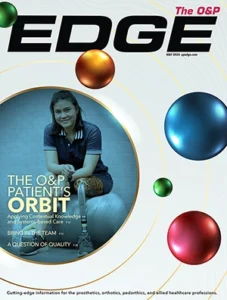Hi friends,
Below are the responses that I received for tibial tendon dysfunction. Names
withheld for privacy.
Couple of resposes were deleted by accident. one of them suggested Solid
Ankle Afo strictly for stage 3. Another one suggested greater emmphasis on
the ground reaction forces while fabricating the orthosis.
————————————————————————————————————————-
I typically use a type like the Ritchie or seattle system but to prevent the
excessive pressure needed on the medial aspect of foot, I have been real
successful with fabricating a foot orthotic first and then pulling the AFO
over it. This allows for a tolerable but strong support on the arch without
the rigidity of the plastic. Compliance has greatly improved and these
patients rave about the comfort. Makes it a fun populationj to work with.
On the fot orthotic I fill the arch with foam before pulling lastic.
————————————————————————————————————————————–
A patient exhibiting PTTD stages one and two are candidates for an
articulating AFO with a 4mm intrinsic heel wedge and possible valgus
control forefoot wedge of 4mm.
There should not be a problem with excessive pressure on the medial
malleolous and talo-navicular areas in stages I and II PTTD. These
particular patients do quite well.
The problem occurs at stage III PTTD, when you have mid-foot collapse
and moderate to severe forefoot abduction. The foot needs total control
with the use of a total contact hydrostatic type AFO, hence the leather
gauntlet. You can accommodate the bony prominence of the TN with a soft
tissue supplement to alleviate undue pressure.
———————————————————————————————————————————–
I’ve tried the two deisgns you mentioned as well as various articulated and
solid ankle configurations. All have had marginal results. Please post
your replies.
—————————————————————————————————————-
We have designed and use an articulated design with a full-coverage
footplate that disperses the corrective forces over a greater area of the
foot. For most persons we use TPE instead of the more rigid plastics to
provide even greater comfort.The articulated design helps to stretch the
heel cord and peroneals gradually as the patient ambulates pain free, and
prevents the compressive forces working on the medial complex as the tibia
advances over the fixed foot. We have used this design for over 12 years and
it works exceptionally well
————————————————————————————————————————————
The JPO (Journal of Prosthetics and Orthotics) had an excellent article on
this in it’s Winter 1999 edition. If you visit their website you may be
able to access it.
———————————————————————————————————————————–
I’ve provided an AFO with an interal “T-strap”. The “T-strap” is padded and
upside down. It secured to a buckle on the lateral side of the AFO.
———————————————————————————————————————————–
The Posterior Tibialis dysfunction is more complex than once thought. I
have been very successful utilizing Triplanar Internal Rotary Pattern (IRP)
Control Foot orthoses. The Posterior Tibialis dysfunction is clearly a
three dimensional problem and the best solution is realigning the foot in
each plane and maintaining the corrected positioning under load bearing
conditions. When properly done, the stresses on the Posterior Tibialis
tendon will be relieved. The tenderness will take time to resolve and once
a client is predisposed to this condition, they may require this type of
triplanar FO for long term use.
This technique requires a greater understanding, skill, time, and therefore
more money to properly help people suffering from this condition. The same
technique can be utilized in your AFO/ KAFO clients with IRP control
problems.
Once you master these techniques, you will notice your clients balance will
improve and many other positive benefits, which will lead to better
outcomes.
—————————————————————————————————————————————
A effective Ground Reaction Orthosis
is necessary. To control the foot, you must harness these forces. If you do
not the GRF in late stance will simple overwhelm any other system you put in
place. We use prepreg composites to construct the basic A.F.O.. This is
designed to be dynamic. Within the full length foot section we fit an inner
U.C.B.L. like shell. Within the shell a three dimensional padding with
aggressive support to the sustentaculum tali.
———————————————————————————————-
Thank you all who responded.have a great weekend.
Burhan Dhar CPO




